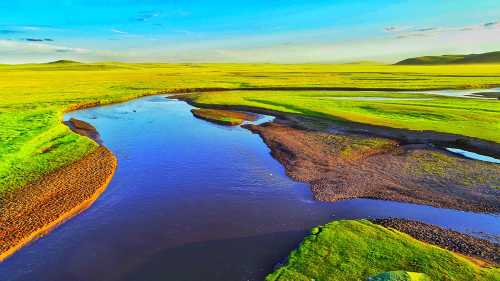Popular Trip Moments
Trip to Changchun, Manzhouli, and Lake Baikal: Manzhouli | Experience the earliest autumn in China at the Greater Khingan Mountains | 5 Days and 6 Nights Exploring the Hulunbuir Grassland | 7 Days and 6 Nights Exploring Hulunbuir|Stay in the Heart of China’s Largest Grassland and Give Freedom Back to Your Soul | Hulunbuir 4 Days 3 Nights Luxury Autumn Tour Guide! Explore the Oil Painting Grassland! | Self-driving on the Shiwei-Manzhouli Border Highway in Autumn | Unlock the secret of the grasslands! A big reveal of Hulunbuir's off-the-beaten-path autumn activities | Step into a golden fairy tale world! Hailar Autumn Healing Trip Guide | Prairie humming run, smiling in the autumn breeze | Hulunbuir Grassland Trip | From Hailar to Arxan, Encounter the Most Beautiful Ewenki Banner
This autumn, I finally fulfilled my dream of visiting the Inner Mongolia Grassland! Starting from Hailar | How to Tour Morigele River in Inner Mongolia | Chen Barhu Banner Winter Ice and Snow Festival Begins | Hulunbuir Autumn Chase Day 3 | Mordaoga National Forest Park | Galloping on the Great Grassland | 【Inner Mongolia Hulunbuir: The Heartbeat Code of the Grassland Kingdom and Mongolian Civilization | journey to the west 🤠 | Morigele River, I finally come to see you | Hulunbuir 8 Days 7 Nights Travel Guide | The autumn in the Greater Khingan Range is absolutely wild!!! | Autumn in Northern Xinjiang: Hulunbuir + Arxan Travel Guide | Autumn in Northern Xinjiang! A Comprehensive Guide to Hulunbuir and Arxan | Golden Autumn in Northern Xinjiang! | Autumn in Northern Xinjiang: Hulunbuir & Arxan Guide | Autumn in Northern Xinjiang: Hulunbuir & Arxan Guide | Autumn Travel Guide: Hulunbuir + Arxan | National Geographic didn't lie! The autumn scenery of Arxan in September is divine. | Autumn Exclusive! A Comprehensive Guide to Hulunbuir and Arxan | Autumn Travel Guide: Hulunbuir & Arxan | Autumn in Northern Xinjiang: Hulunbuir and Arxan Travel Guide | Autumn in Northern Xinjiang: Hulunbuir & Arxan Guide
Recommended Attractions at Popular Destinations
Popular Attractions in Sydney | Popular Attractions in Dubai | Popular Attractions in Paris | Popular Attractions in Shanghai | Popular Attractions in Phuket | Popular Attractions in New York | Popular Attractions in Tokyo | Popular Attractions in Bali | Popular Attractions in Melbourne | Popular Attractions in West Lake | Popular Attractions in Iguazu National Park(Argentina) | Popular Attractions in London | Popular Attractions in Rome | Popular Attractions in Kuala Lumpur | Popular Attractions in Chefchaouene | Popular Attractions in Singapore | Popular Attractions in Kyoto | Popular Attractions in Los Angeles | Popular Attractions in Zanzibar Island | Popular Attractions in Las Vegas | Popular Attractions in Osaka | Popular Attractions in Walt Disney World Resort | Popular Attractions in Beijing | Popular Attractions in Bangkok | Popular Attractions in Barcelona | Popular Attractions in Chengdu | Popular Attractions in Florence | Popular Attractions in Madrid | Popular Attractions in Jungfrau Region | Popular Attractions in Istanbul
Popular Attractions
Little Qingdao | Nanshan Scenic Area | Zhongshan Park | Quyuanfenghe (Breeze-Rustled Lotus In Quyuan Garden) | Huashilou House | LaoLong Jing Yu ChaYuan | Dai Temple | Queen Mother Pond | The Place to Which Confucius Climbed to Command a Broad View | Nantian Gate | Azure Cloud Temple | Duanqiao Canxue | Eighteen Twistings | Zhuhai Fisherwoman | Baiteng Lake | Nanwan Monkey Islet | Hailing Pearl Cultivation Farm | Xiangshui (Perfume) Bay | Masjid Darul Falah Blingijati | Rajendra Park Durg | Sarriko Parkea | Letreiro Boutique do Peixe (MB) | Muzey Mineralogii | Golf-Club Ingolstadt e.V. | Masjid-E-Muhammadiya (Ahle Hadees Masjid) | Ferndale Park | Srikalahasti | Stadion Seri Musim Lampuuk | Qichangcheng Ruins | Inscribed Stones on Mount Tai of the Qin Dynasty
Popular Restaurants in Old Barag Banner
鑫牧马人饭店 | 聚薪斋 | 莫尔格勒宾馆 | 牧羊春火锅城 | MO RI GE LE MENG GU DA YING | 牧缘饭店 | 天下草原蒙古餐厅 | 落日景观餐厅 | 碧野情阁饭庄 | 华海火锅城 | 蒙古人饭店 | 鑫香源火锅城 | 陈巴尔虎旗东乌珠尔苏木大草原美食府 | 呼伦贝尔陈巴尔虎旗海纳蒙古庄园·餐厅 | 庆格尔泰民宿·营地餐厅 | 爱情麻辣烫(呼伦街店) | 鲜鱼馆 | 碰碰凉(陈旗店) | 察哈尔蒙餐 | 桂霞饭店 | 杭盖锅茶主题餐厅(弘盛嘉园小区店) | 哈伦蒙古餐厅 | 吉祥馄饨面(呼伦街店) | 那达慕肉干面 | 阿庆烤肉馆 | 陈旗宝镇东北菜馆 | 孟根塔拉酒店 | 九九鸭脖王(安奔街店) | 山寨砂锅麻辣烫 | 惠香源烤肉(陈巴尔虎旗巴音佳园小区店)
Popular Ranked Lists
Top 10 Trending Attractions in Dubai | Top 50 Must-Visit Restaurants in Chaozhou | Top 50 Must-Visit Restaurants in Fukuoka | Top 10 Trending Attractions in Hangzhou | Top 50 Must-Visit Restaurants in Santorini | Top 10 Trending Attractions in Kunming | Top 20 Luxury Hotels in Sanya | Top 20 Premium Hotels in Dali Prefecture | Top 50 Must-Visit Restaurants in Xi'an | Top 20 Trending Attractions in Wuhan | Top 50 Must-Visit Restaurants in Ho Chi Minh City | Top 10 Trending Attractions in Hong Kong | Top 10 Premium Hotels in Nyingchi | Popular Trending Attractions in London | Top 50 Must-Visit Restaurants in San Francisco | Top 50 Must-Visit Restaurants in Frankfurt | Popular Trending Attractions in Hefei | Top 50 Must-Visit Restaurants in Auckland | Top 50 Must-Visit Restaurants in New York | Top 50 Must-Visit Restaurants in Langkawi | Top 50 Must-Visit Restaurants in Rome | Top 10 Trending Attractions in Qingdao | Top 10 Trending Attractions in Tianjin | Top 20 Trending Attractions in Guangzhou | Top 50 Must-Visit Restaurants in Songyang | Popular Trending Attractions in Shaoxing | Top 50 Must-Visit Restaurants in London | Top 50 Must-Visit Restaurants in Bruges | Popular Luxury Hotels in Ningbo | Popular Trending Attractions in Wuyuan
About
Payment methods
Our partners
Copyright © 2025 Trip.com Travel Singapore Pte. Ltd. All rights reserved
Site Operator: Trip.com Travel Singapore Pte. Ltd.
Site Operator: Trip.com Travel Singapore Pte. Ltd.























